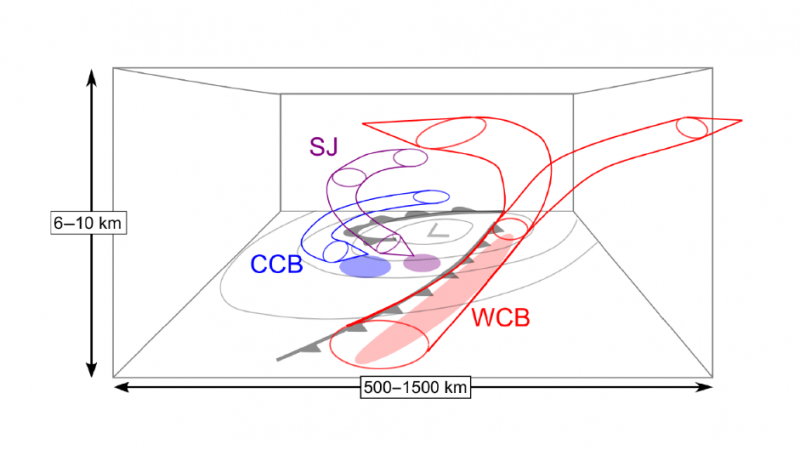The project aim is to develop a prototype real-time tool for use by Met Office forecasters to identify storms containing a feature known as a sting jet and so improve national severe weather warnings and thus climate resilience.
Sting jets are descending airstreams that have led to damaging surface winds and gusts in autumn and winter storms including the Great Storm (1987) and more recent St Jude’s day (2013) and Georgina (2018) windstorms. A convective-instability-based sting jet precursor has been developed by the project team to identify these storms in datasets unable to represent sting jets due to insufficient spatial resolution. The diagnostic code will be adapted to work routinely on operational global ensemble forecast output to inform forecasters whether or not storms impacting the UK and Europe up to seven days in the future have the precursor. We will work with forecasters to develop suitable graphical outputs and trial the prototype tool during autumn and winter 2019. If successful, the Met Office anticipate implementing the tool within their model system.
Sting jets are descending airstreams that can lead to damaging surface winds and gusts in autumn and winter storms. UK impacting sting-jet storms include the Great Storm (1987) and the more recent St Jude’s day (2013) and Georgina (2018) windstorms. A convective-instability-based precursor to sting jets has been developed by the project team to identify these storms in datasets unable to represent sting jets due to insufficient spatial resolution. These datasets include reanalyses and global ensemble weather forecast model output. Climatological analysis has shown that this precursor is present in about 30% of all North Atlantic storms, increasing to about 40% for explosively-developing storms.
A similar analysis applied to end of 21st century climate-model output using the most extreme (RCP8.5) climate forcing scenario found a 60% increase in explosively-developing storms with the precursor. Furthermore, even in reanalyses, storms with the precursor are the dominant cause of storm-related strong UK winds. In reality these winds will be enhanced by the actual occurrence of sting jets.
Early detection of storms with the precursor could give advanced warning of enhanced wind risk and so improve national severe weather warnings and thus climate resilience. The project aim is to develop a prototype real-time precursor tool for use by Met Office forecasters. The existing precursor diagnostic code will be adapted to work routinely on operational global ensemble forecast output to inform forecasters whether or not storms impacting the UK and Europe up to seven days in the future have the precursor. We will work with forecasters to develop suitable graphical outputs and trial the prototype tool during autumn and winter 2019. If the prototype tool is successful then the Met Office anticipate implementing it within their model system such that the sting-jet precursor diagnostic would be available to all their prediction systems.

Publications
- Gray, S.L., Martínez-Alvarado, O., Ackerley, D. and Suri, D. 2020. Development of a prototype real-time sting-jet precursor tool for forecasters. Weather.

